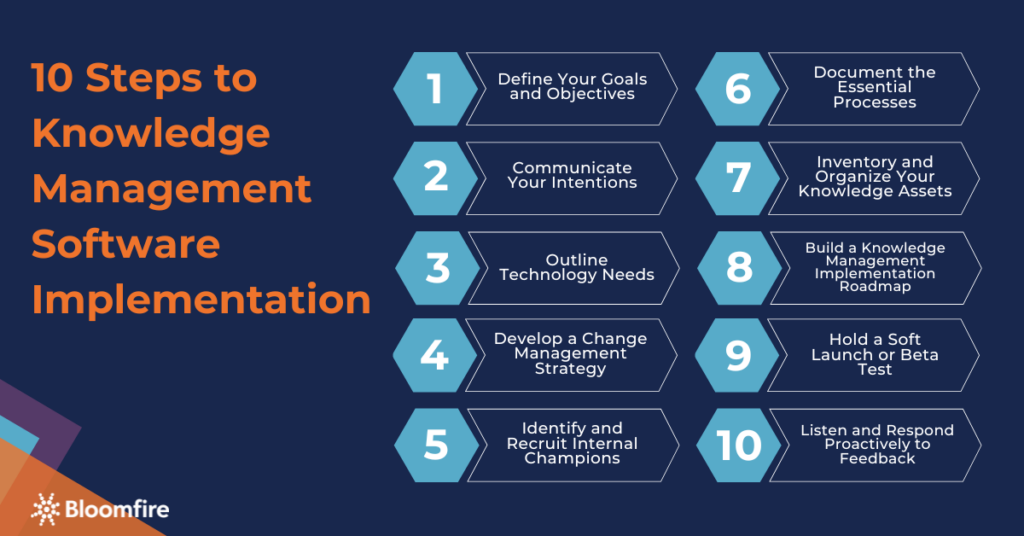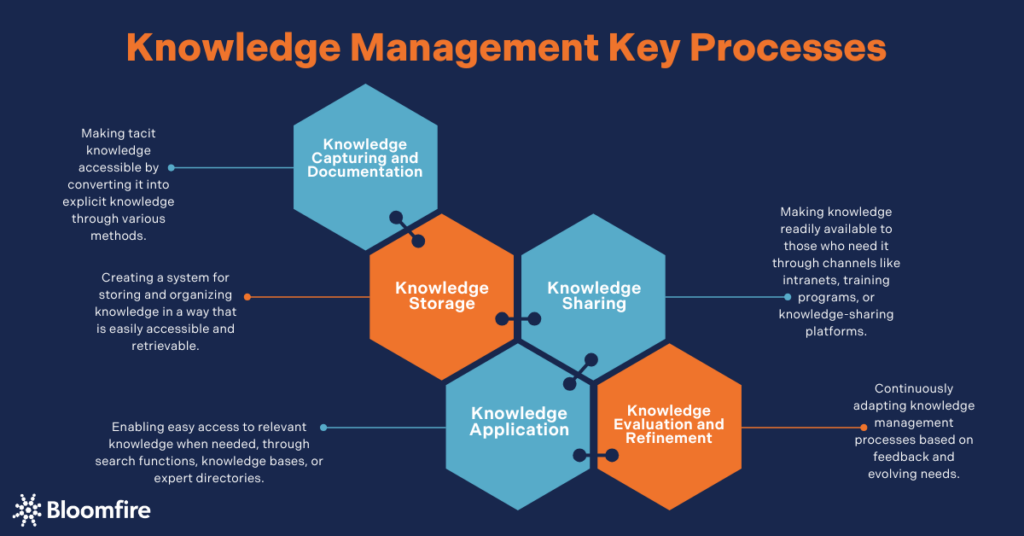How to Implement Knowledge Management Software Successfully (+ Key Factors to Consider)

Companies allocate a significant budget for software and digital tools. Thus, if technology is not implemented correctly or you don’t adequately prepare your employees for change, it can drain your company. In the case of a knowledge management system, failure to implement the solution can potentially cost you millions of dollars as a direct result of loss of productivity–that’s not to mention the technology spend itself.
To prevent these pitfalls, we have compiled the critical steps to implement knowledge management software successfully–from defining your goals and developing a change management strategy to building an implementation plan, conducting a pilot launch, and responding to feedback. We also present the key knowledge management factors that influence the success of the system’s implementation.

1. Define Your Goals and Objectives
Defining your goals and objectives should be the first step with any technology implementation. Some organizations fail to realize that this is one of the biggest reasons knowledge management implementation fails. In fact, on a wider scale, the lack of clear goals accounts for 37% of project failures.
When defining goals and objectives for a knowledge management initiative, engage representatives from each affected department early in the planning process. This collaborative approach ensures alignment and buy-in across the organization. Facilitating discussions with department heads and key leaders will foster a shared understanding of the desired outcomes. Plus, it establishes a clear roadmap for successful implementation.
“Think about the specific business goals you hope to achieve and which metrics you’ll track to determine whether or not you achieve those goals. It’s important that you set yourself up to measure ROI down the road.”
Setting your goals will also help you determine how to measure performance and define success and return on investment (ROI). The more specific you are, the easier it will be to track your progress.
2. Communicate Your Intentions
After defining the strategic goals and objectives, communicate the implementation plan to the team, ensuring transparency and alignment. Emphasize the “why” behind the change. Highlight how the new platform will positively impact individual roles and responsibilities while contributing to the overall organizational success.
“If nothing else, defining and communicating your goals with the platform helps end-users to distinguish it from the other ten platforms your organization uses. I see many companies that have what I call ‘new software fatigue.’ The best way to cure software fatigue is to communicate the specific purpose of your knowledge engagement platform clearly and often.”
Illustrate with concrete examples how this transition will streamline daily tasks and improve workflows. Don’t be afraid to address some of your organization’s knowledge management challenges as soon as the software acquisition plan is announced.
For example, explain the productivity and monetary losses when your customer service team can’t find the information they need to help customers or when your sales team takes too long to onboard new reps. The same consequences may happen when marketing notices a lack of consistent branding. Help them see the pain points the platform can address and the KM benefits the entire company will experience when the solution is fully implemented.
3. Outline Technology Needs
Once you clearly understand (and document) your intentions, objectives, and goals, it’s time to outline your technology needs. Identifying your non-negotiable knowledge management platform functionalities can help you narrow down potential solutions that align with your needs.
For example, if your knowledge-sharing strategy includes publishing extensive training videos and enabling employees to navigate these videos using keyword search, prioritize platforms offering advanced video indexing capabilities.
As you evaluate your options, focus on the big-picture problems and make them as references when choosing the right knowledge management system for your organization. During your meetings with different vendors, assess if they can demonstrate how their solution solves these problems.
An Intuitive KM System for Enterprise
Bloomfire has advanced enterprise tools that enable seamless knowledge management implementation.
Explore Bloomfire
4. Develop a Change Management Strategy
Even though you’ve established your goals and objectives, it’s imperative to understand that change doesn’t happen overnight. With a failure rate of roughly 70% in organizational change initiatives, it’s more important to recognize and develop a strategy for continuous change management.
Simply put, a change management strategy is your roadmap for navigating any company transformation–regardless of scale–to ensure your people are on board and ready to embrace the new. Organizational change can be challenging, but seamlessly integrating new solutions into daily discourse fosters familiarity and encourages adoption.
“To a certain extent, it doesn’t matter how good your software is if you don’t have a solid plan for adoption. Change management is the human side of process improvement. You can’t have one without the other.”
As part of your change management process, promote ongoing dialogue and embed your knowledge management solution within routine interactions as part of your change management process. These actions will empower employees to comfortably explore its functionalities, seek clarification, and ultimately champion its benefits.
5. Identify and Recruit Internal Champions
Employees will likely use your knowledge management platform if they see leaders and their peers succeeding. Identify one or multiple members of your organization to be your internal champions. These individuals must be driven, upbeat, and eager to drive organizational change.
Your internal champions will be instrumental in cultivating enthusiasm and driving engagement surrounding the knowledge management platform launch. Furthermore, these champions will play a key role in our soft launch phase. Their early adoption and feedback will help refine the platform and ensure a smooth transition for the broader organization.
“Resist the urge to get feedback only from the folks who are excited about the new initiative,” she says. “Early naysayers and critics can provide some of your most valuable feedback throughout the implementation process. And once you’ve converted them, they’ll be your best advocates.”
Cultivating a successful knowledge management environment requires actively listening to and engaging with key champions within the organization. When these individuals express concerns or encounter obstacles, identify the root causes of their dissatisfaction. Their feedback often provides valuable insights into broader organizational challenges and potential areas for improvement within the knowledge management system.
6. Document the Essential Processes
Fostering a culture of documentation is essential in any knowledge management system, even with the most user-friendly platforms. Providing guidance on fundamental processes, especially for those unfamiliar with knowledge documentation practices, facilitates efficient onboarding and consistent usage.
But, beyond basic platform operation, establishing comprehensive, high-level processes sets a robust KM framework for knowledge creation, sharing, and utilization. This is across diverse teams, ensuring alignment and fostering a cohesive knowledge ecosystem.

For example, you might introduce a content review process in which subject matter experts (SMEs) write a post draft in your knowledge management platform, and designated moderators review and approve (or provide feedback and request revisions) within a specified time frame. You might also develop templates to guide contributors in creating certain standardized content types.
When establishing processes for your knowledge management system, recognize that these initial frameworks will likely evolve as your organization learns and adapts. Observe how your teams organically interact with the platform, identify use patterns, and leverage these insights to refine your processes.
7. Inventory and Organize Your Knowledge Assets
Establishing a clear and intuitive knowledge hierarchy is essential when building a robust knowledge base. This structure facilitates seamless browsing and content discovery for new users and lays the groundwork for effective content curation in the future.
Take the time to think about a knowledge structure that makes sense for your organization. Gather feedback from team leaders and work with your knowledge management platform provider to learn how other customers have structured their information and why it works for them.
“During this step, I always recommend that you ‘Marie Kondo’ your content. Select only the most relevant and recent information to migrate into the community. Outdated research, obsolete policies, and peripheral documents will clutter your community and make it difficult for users to find the most current and up-to-date knowledge.”
By making the process of using the platform as easy and streamlined as possible from day one, you can reduce friction and immediately foster better engagement that helps implement knowledge management software successfully.
8. Build a Knowledge Management Implementation Roadmap
Stay on track as you prepare to roll out a new knowledge management system by developing an implementation roadmap. Your roadmap acts as a guide, outlining key activities (e.g., beta testing, internal communications, your official launch), timelines, and resources needed to effectively capture, organize, and share knowledge throughout the entire software implementation lifecycle.
As you develop your roadmap, ask yourself the following questions:
- Are there any factors that require us to launch by a particular date (e.g., a need to launch ahead of a busy holiday season)?
- Are there teams or individuals who will use the platform before the official launch (e.g., beta testers)?
- Who needs to be involved (and who will own specific activities) at each point on the roadmap?
- When should we start communicating about our new knowledge management initiative? How many communication touchpoints should there be (and what should they be)?
- What do we want our training schedule to look like?
With a comprehensive knowledge management implementation roadmap, organizations can foster a smooth transition, minimize disruption, and empower users to quickly adopt and leverage the new software. This proactive approach increases user satisfaction, improves efficiency, and drives a more significant ROI.
9. Hold a Soft Launch or Beta Test
Conduct a pilot launch with the key internal stakeholders you previously identified to achieve seamless integration and optimal functionality of your knowledge structure. This collaborative approach will allow for valuable feedback and iterative refinement, ensuring the system effectively addresses the unique needs and challenges of the organization.
Start your soft launch with quick training surrounding best practices on using the platform. This is also a good time to reiterate the goals and objectives. Let your internal champions (and a few tough critics) use the platform for about two weeks as a test period and have an early assessment of the knowledge management implementation.
“Whether your soft launch is a full-blown beta test with a User Acceptance Testing assignment or a one-hour meeting where future users can play around with the new tool, this is a great opportunity to gather and address initial feedback. It’s important to get ahead of any potential friction points before you officially launch.”
Power Move: If you still lack the confidence to facilitate a successful knowledge management implementation, our project managers have developed a four-stage enterprise ignition service. This covers planning, configuring the platform, seeding content, and launching to end-users. Schedule a demo meeting with Bloomfire to learn more about this service.
10. Listen and Respond Proactively to Feedback
After the soft launch period, meet with your internal champions and critics and gather as much feedback as possible. Encourage candid feedback and solicit their perspectives on all aspects of the platform, from its strengths to any challenges encountered. Remember, these individuals are your frontline users, and all feedback is warranted.
Prioritize addressing any issues or concerns raised during the soft launch to ensure a smooth and positive experience for the broader organization. Strategize ways to fix these issues to set up a successful rollout for the rest of the company. When everything is all said and done, thank your internal champions for their participation with a gift or lunch.
“Make sure all end-users have a consistent way to share feedback, either in real-time with an on-demand form or by sending biannual surveys. This will not only help you improve the platform as the needs of the organization evolve, but it will also allow you to build trust with your user base.”
As you move forward, keep the lines of communication open and consistently ask for more feedback to further optimize the user experience. This commitment to ongoing improvement fosters a sense of ownership and collaboration, ultimately driving platform adoption and knowledge sharing across the organization.
Factors of Successful Knowledge Management Implementation
Organizations invest in knowledge management platforms so that employees, whether it’s across an entire organization or within departments, can find and share the information they need to do their jobs. Successfully implementing a knowledge management system requires extensive preparation, patience, and a willingness to learn.
In addition to following the key steps to implement knowledge management software, the following are other key factors that drive its success.
1. Having a Knowledge Directory
When employees have questions, they often go through a chain of people to find the knowledge expert. To reduce the time it takes your employees to find the expert, set up a knowledge directory and bookmark it within your platform. This directory identifies your SMEs in various areas, saving your employees time searching for the knowledge they need to do their jobs.
2. Leadership Team Involvement
Your organization’s executive team visibility in your knowledge management platform launch effort is one of the strongest knowledge management success factors. Business leaders should articulate the goals and objectives, play a role in the soft launch, and be active on the platform. Have your executives make the first post on your platform, welcoming everyone and outlining the goals.
“When you see an email from the CEO in your inbox, there’s no way you aren’t opening it. Executive sponsorship is a really powerful tool to engage users during your launch and beyond.”
Active participation from the leadership team will show how serious they are about creating change and influence your employees’ perspective on its implementation. (We’ve even had customers’ executives post self-recorded videos, a surefire way to drive employee engagement.)
3. Creative Engagement Activities
Who doesn’t love a little friendly competition? To get your team excited about the new knowledge management platform, hold a contest to encourage your employees to dive in and get the lay of the land.
Some of our customers have succeeded with virtual scavenger hunts or bingo games inside their knowledge management platform. They even held contests to choose a name for the new KM community. The prize can be lunch with leadership, a cool new tech gadget, paid time off, or whatever is appropriate for your organization.
4. Continuous Training
Don’t let the hype of your new knowledge management platform die. Hold regular training meetings for your employees to stay current on knowledge management best practices and any important product updates or changes. This is one of the best ways to keep employees engaged and share company knowledge effectively.
“Any significant update to the platform is an opportunity for training and engagement. Whenever you hear from your Customer Success Manager about a new feature, take that as your cue to send out communication and help documentation.”
5. Knowledge-Sharing Culture
If your organization has yet to establish a culture of knowledge sharing, adopting a KM platform can be the springboard for cultivating one among teams. Knowledge sharing is the core of a successful knowledge management initiative.
Continue to encourage your employees to share their expertise, skills, and experiences. It creates a collective intelligence that can be leveraged for problem-solving, innovation, and improved decision-making. Provide a collaborative atmosphere that breaks down information silos, reduces redundant work, and accelerates learning.
Power Move: A foundation for the critical success factors in knowledge management implementation is having a knowledge management partner that offers implementation project management as a service. Bloomfire, for example, offers close guidance in rolling out its solutions and helps organizations overcome common challenges, ensuring successful knowledge management implementation.
Choose a Platform With Implementation Project Management Services
Ensuring the success of your knowledge management implementation requires careful planning and foresight to maximize its use in multiple business areas. To ensure you’re hitting the key factors of knowledge management success, carefully select the platform that corresponds to your business needs and provide ample assistance throughout its implementation and even after.
Work With KM Implementation Experts
Our team will assist you in setting up knowledge management software for success.
Learn More
This post was originally published on May 13, 2015. It was most recently updated and expanded in December 2024 to update the best practices from Bloomfire’s Customer Success team.

What is Data vs. What is Information

How to Build a Career in Knowledge Management in 2025

Start working smarter with Bloomfire
See how Bloomfire helps companies find information, create insights, and maximize value of their most important knowledge.

Take a self guided Tour
See Bloomfire in action across several potential configurations. Imagine the potential of your team when they stop searching and start finding critical knowledge.
